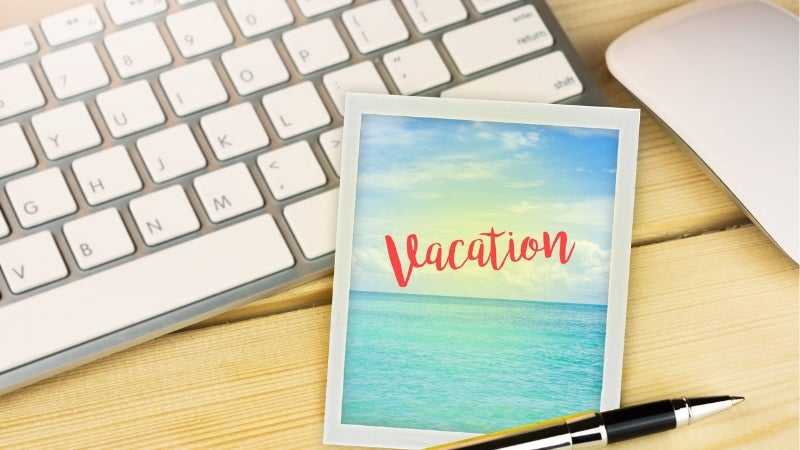How to Budget for the Vacation of Your Dreams
If you're like me, you don’t usually have a ton of cash laying around to spend on a dream vacation. But, even if that is the case, it doesn’t mean you can’t embark on that ideal trip. All it takes is some good budgeting habits and a little bit of planning, and you’ll be boarding before you can say “Bon Voyage!”
By the way, we completely understand that some people prioritize saving up for new things instead of new trips. But research from a study out of San Francisco State University suggests that people who spend money on experiences rather than items are happier overall and feel better about the money they spend – and we’re all about helping you live your best life! Furthermore, Doctor Susan Krauss Whitbourne of Psychology Today claims that vacations are more than just a luxury — they're important for your health. So, our recommendation is to plan for vacations using your existing budget and to leverage those material buys with a .
Do your planned getaways keep getting away from you? Well, follow the few simple guidelines we’ve pointed out below and, in time, you’ll be heading over new horizons.
Calculate Your Current Budget
Saving for your vacation budget starts with analyzing what you can do to keep more of what you make on your current budget. All the money you spend on the trip will come from your savings, so you’ll be looking for ways to direct more of your income into that savings account.
While there are dozens of apps, planners, and services surrounding – an easy way to get a ballpark figure of what your budgeting might look like is the 50/30/20 rule.
Here’s how it works: 50% of your take-home income goes to bills and necessities (like food, loan payments, insurance, etc.), 30% goes to “wants”, and the remaining 20% goes to your savings. This 20% is what you’ll use to save for your vacation. For example, if your take-home pay after taxes and deductions is $3,000 per month, $1,500 would go toward your bills and necessities, $900 would go towards “wants”, and $600 would go toward savings.
Getting a clear view of your current financial situation is key to building a budgeting roadmap which will get you on your trip as soon as possible.

Research Travel Costs
Regardless of whether it’s planes, trains, or automobiles, it’s going to cost you to get to your destination. Depending on where you’re going, this may very well be the biggest expense of your vacation budget.
Start planning several months in advance so you have options, and be sure to use trip planning and comparison services like Google Trips, KAYAK, and Hopper. With these tools in your belt, you’ll be able to compare travel options and agencies from a single dashboard – and you’ll even gain insights on when prices are predicted to change so that you can be on top of your savings game!
Set Spending Limits
Just as important as your savings before the trip, your spending during the trip will cover everything you do for fun and leisure. It’s important to consider and cover everything that might cost money – both for daily spending and for your “living it up a little” expenses.
These could include:
- Hotels / Lodging
- Travel within the area (like Uber rides and bus tickets)
- Food
- Souvenirs, and
- Other Expenses– you can never plan for these, so it’s always best to be prepared.

Make the Trip Fit Your Budget and Adjust as Needed
Once you’ve added up your travel costs and spending limits for your trip, you’ll need to determine if the allocated 20% of your monthly take-home pay will be enough to get you out the door in time.
Let’s say your trip is looking like it will be $2,000 total. Based on the sample budget I used earlier, if your 20% is the $600 available per month, it would take you a little over three months to save up enough to pay for the trip. If your trip is three months away or more, you shouldn’t need to make any adjustments to your saving habits.
However, if the 20% that you’re currently setting aside per month won’t be enough in time for your trip, we recommend one of the two following options:
The first, and our preferred, option is to reallocate some of your “wants” budget to your saving efforts. In the case above, if you could find a way to shift $300 (roughly the cost of a McDonald’s Frappé per day) from your “wants” category to your savings, you’d be able to afford your trip about a month faster. Your other option is to adjust the trip itself. This could be slightly more complicated, but it could include moving the trip to a later date, trimming a day or two off the duration, or changing your travel methods or accommodations.
Regardless of the way you address any shortfalls, try not to cut into your daily spending allotment. Depriving yourself or restricting your budget too much on vacation can take the fun out of it. After all, you’re there to relax and enjoy yourself, not pinch pennies and worry if you’ll be able to afford that coconut guava parfait at the tiki lounge that you’ve been eyeing-up since breakfast. Save where you can, but try to bring enough cash so you won’t have to think about it.

Stay Motivated
Let’s face it, saving money can be tough, especially when your trip is months away. Sometimes it can be tempting to spend extra cash along the way, whether that means getting a pair of shoes that were on sale or eating out too many times during the week. If you find yourself straying every now and then, don’t get too upset about it — sometimes you may just need a little motivation to fend off the impulse buys and splurging.
If you’re using a savings account that allows you to change the name, consider naming it after your trip to keep your goal in view every time you log into your account. Saving is just as much a force of habit as it is a state of mind – so a constant reminder of what you’re working toward is never a bad idea.
Keeping a picture on your desk is another helpful method, or maybe changing the background on your phone or computer desktop to a picture of where you’re going. These mementos will encourage you to stay focused on your goal, which in turn keeps you excited about your vacation and motivates you to be more frugal while saving up in the meantime.
Vacations are key to living a healthy and successful life – so don’t let money be the barrier that holds you back from going on the journeys of your dreams. Plan ahead, save, and keep your eyes on the prize – you’ll be on your way in no time.
For a quick overview of some budgeting tips, check out the YouTube video below. And be sure to visit some of our other posts on the for even more tips on traveling, financial planning, and budgeting.
More Articles
What to Know About Crypto-Backed Loans
Curious about using your crypto as collateral? Discover how crypto-backed loans work, their benefits, risks, and what to consider before borrowing.
Read More >How Does Installment Loan Approval Work?
Curious about how installment loan approval works? Learn about the key factors lenders consider, the application process, and tips to improve your chances of approval.
Read More >Is it Better to Get an Installment Loan or Line of Credit?
Installment loan or line of credit—which is right for you? Learn the key differences, pros and cons, and how to choose the best option for your financial needs.
Read More >Loan Amount is subject to loan approval. Loan terms and availability may vary by location. Approval rate based on complete applications received across all Cash Store locations. Customers can typically expect to receive loan proceeds in less than 20 minutes; however, processing times may vary. Loans / Advances are provided based on approved credit. Each applicant for credit is evaluated for creditworthiness.
Please see the Licenses and Rates page for additional product details.
Cash Store offers consumer credit products that are generally short-term in nature and not intended for long-term borrowing needs.
In Texas, Cash Store is a Credit Services Organization. Loans are provided by a non-affiliated third-party lender. Please see the Licenses and Rates page for links to Consumer Disclosures and choose the one for the product and amount that most closely relates to your loan request.
Customer Portal residency restrictions apply. Availability of funds may vary by financial institution.

